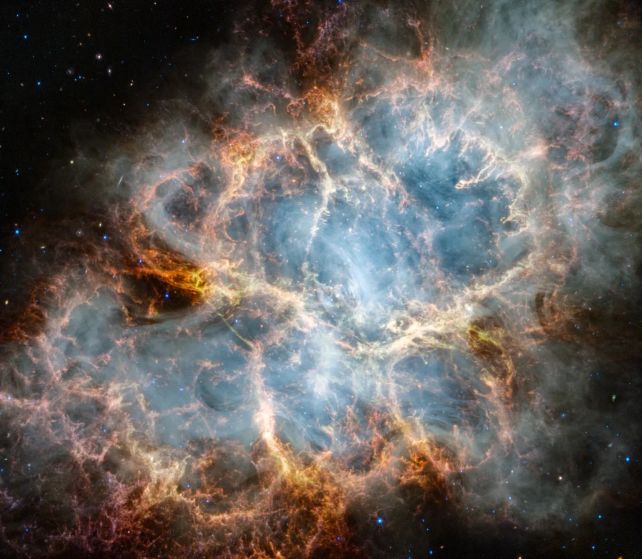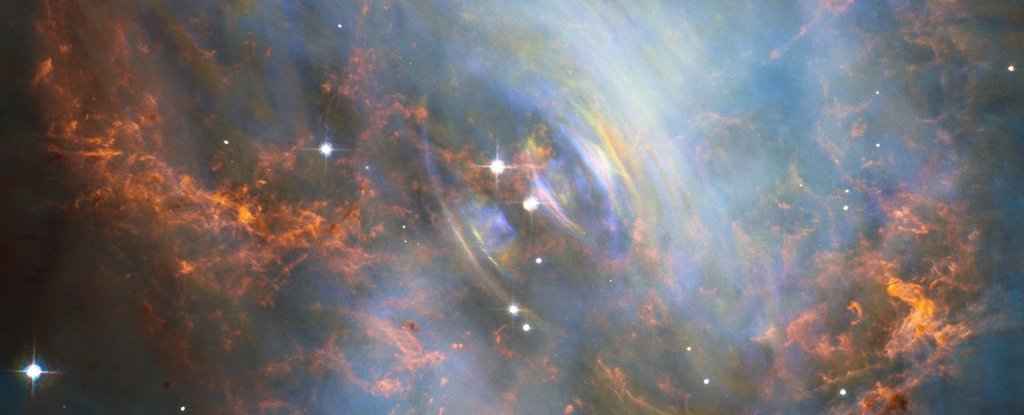From within a glowing web expanding outward from an epic explosion, a dead star is flashing pulses of radio light at Earth.
This is the Crab Pulsar, and within its radio pulses is a strange signal that has puzzled astronomers for years. Called the zebra pattern, it looks like a strange spacing of wavelength bands when graphed, resembling the spiky zig-zag stripes of a zebra.
Nothing else in space has an emission quite like it, and astronomers have sought an explanation since the pattern was first observed nearly two decades ago.
Now, a theoretical astrophysicist thinks he may have solved the mystery.
It is, says Mikhail Medvedev of the University of Kansas, an interference pattern generated by the diffraction of light by different plasma densities inside the pulsar’s magnetosphere.
“If you have a screen and an electromagnetic wave passes by, the wave doesn’t propagate straight through,” Medvedev explains.
“In geometrical optics, shadows cast by obstacles would extend indefinitely – if you’re in the shadow, there’s no light; outside of it, you see light. But wave optics introduces a different behavior – waves bend around obstacles and interfere with each other, creating a sequence of bright and dim fringes due to constructive and destructive interference.”
The Crab Pulsar is the hectic remnant of a supernova some 6,200 light-years away that bloomed in Earth’s sky in 1054 CE. It was the spectacular death of a massive star ejecting its outer material in a violent sneeze. The core at the star’s center – no longer supported by the outward pressure of fusion – collapsed under gravity to form a neutron star.
These ultra-dense objects are tiny, the heaviest packing up to 2.3 times the mass of the Sun into a sphere just 20 kilometers (12 miles) across. A pulsar is a type of neutron star that blasts jets of radio waves from its poles. As the star rotates at incredible speeds, these jets are like lighthouse beams that sweep past Earth in such a way that the star appears to pulse.
The Crab Pulsar has a rotational period of about 33 milliseconds, which means it pulses about 30 times a second.
frameborder=”0″ allow=”accelerometer; autoplay; clipboard-write; encrypted-media; gyroscope; picture-in-picture; web-share” referrerpolicy=”strict-origin-when-cross-origin” allowfullscreen>
Astronomers have been studying this pulsar since its discovery in the 1960s in the middle of the bubble of expanding debris, making it the first star to be confidently linked to a supernova event. It still has its mysteries more than half a century on: the mysterious zebra pattern wasn’t discovered until 2007, and boy was it a conundrum.
“It’s very bright, across practically all wave bands,” Medvedev says. “This is the only object we know of that produces the zebra pattern, and it only appears in a single emission component from the Crab Pulsar. The main pulse is a broadband pulse, typical of most pulsars, with other broadband components common to neutron stars. However, the high-frequency interpulse is unique, ranging between 5 and 30 gigahertz – frequencies similar to those in a microwave oven.”
Since we’ve been observing the pulsar so intently for so long, there’s a wealth of observation data available. Medvedev took this data and, working from the assumption that the zebra pattern represents a diffraction fringe, developed a model based on wave optics to calculate the pulsar’s plasma density.
The model accurately replicated the observations, providing a deft explanation for the pulsar’s strange behavior. As the radio waves beam out from the pulsar, Medvedev found, interactions between the plasma and the magnetic field produce a diffraction interference pattern that looks like zig-zag zebra stripes.

“A typical diffraction pattern would produce evenly spaced fringes if we just had a neutron star as a shield,” Medvedev says.
“But here, the neutron star’s magnetic field generates charged particles constituting a dense plasma, which varies with distance from the star. As a radio wave propagates through the plasma, it passes through dilute areas but is reflected by dense plasma. This reflection varies by frequency: Low frequencies reflect at large radii, casting a bigger shadow, while high frequencies create smaller shadows, resulting in different fringe spacing.”
The model could represent a new tool for measuring the plasma density inside the magnetospheres of pulsars and other extreme environments where diffraction patterns can be found. Although there’s nothing in the sky quite like the Crab Pulsar, there are other places and ways the model can be applied.
“The Crab Pulsar is somewhat unique – it’s relatively young by astronomical standards, only about a thousand years old, and highly energetic,” Medvedev says.
“But it’s not alone; we know of hundreds of pulsars, with over a dozen that are also young. Known binary pulsars, which were used to test Einstein’s general relativity theory, can also be explored with the proposed method. This research can indeed broaden our understanding and observation techniques for pulsars, particularly young, energetic ones.”
The research has been published in Physical Review Letters.





